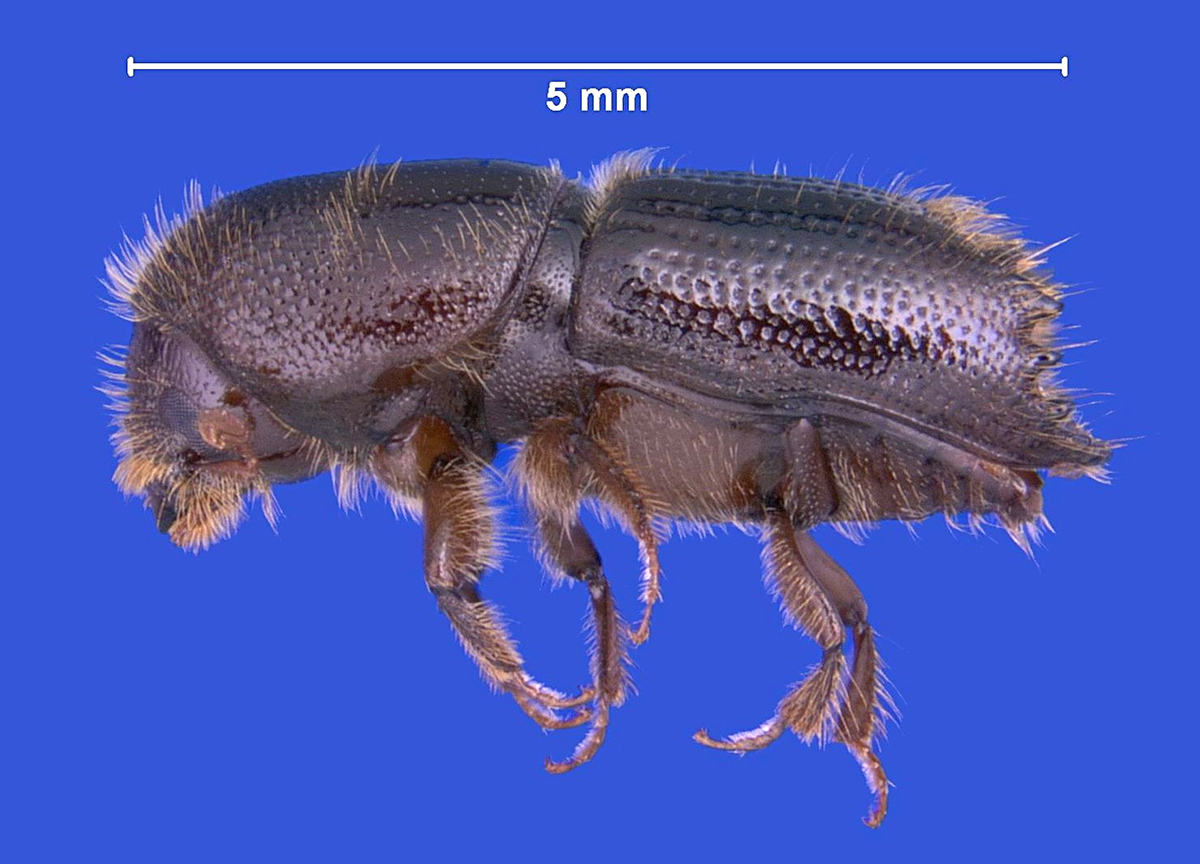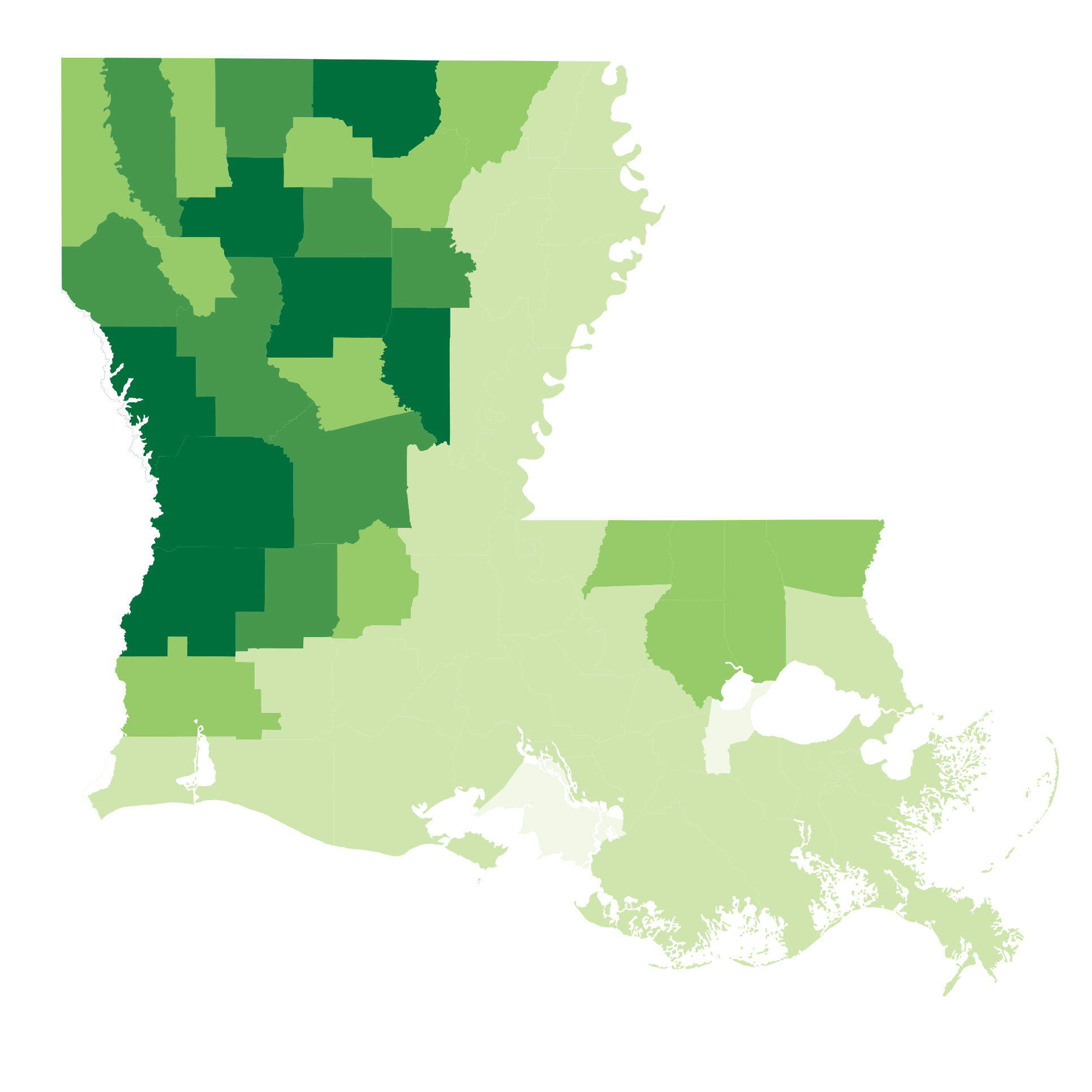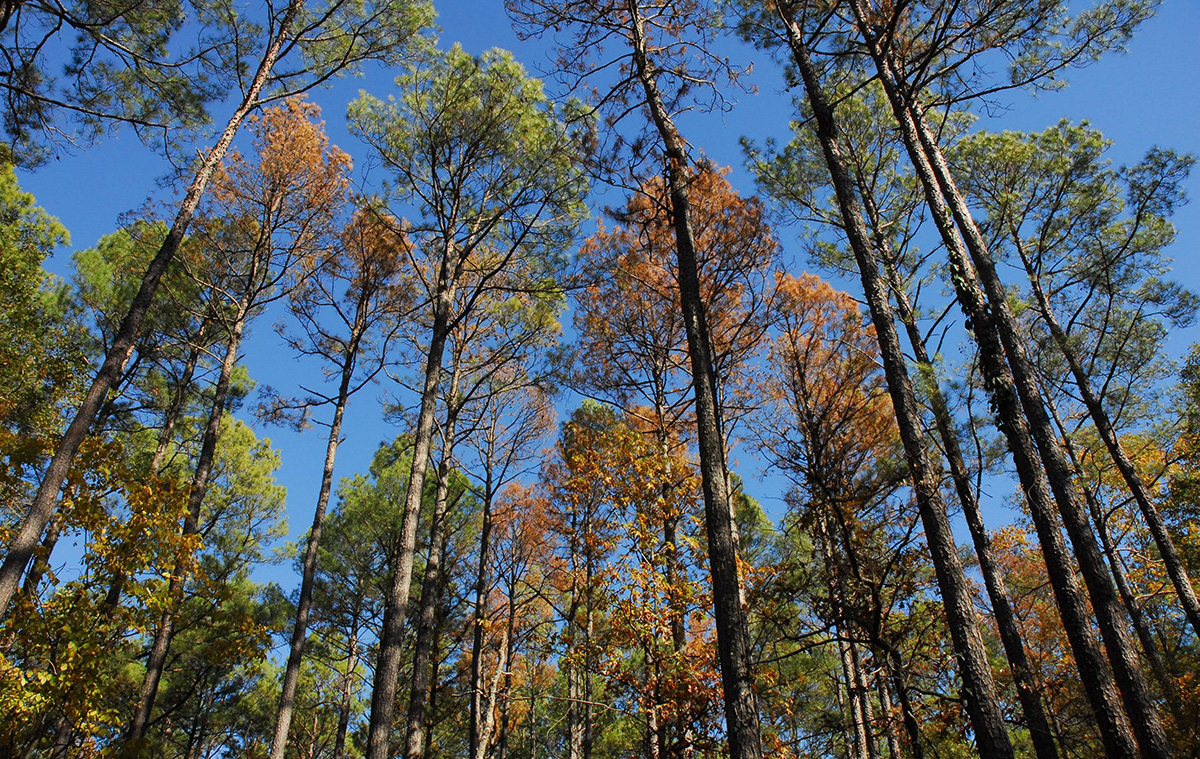Help, I Need Somebody: LSUA Partners with USDA to Investigate Trees Infested by Beetles in Wake of Big Storms
July 01, 2021
Students and faculty at LSU of Alexandria (LSUA) are collaborating with the U.S. Department of Agriculture (USDA) Forest Service Southern Research Station on a project to document the impact hurricanes and tornadoes have on insects in southern forests. And not just cute ones. Downed and damaged trees can be fertile feeding and breeding grounds for bark- and wood-boring beetles, which potentially can spread to healthy trees. With forestry being the largest agricultural industry in the state and storms expected to grow stronger, resulting in more damage—both immediate damage from wind and longer-term collateral damage due to insect infestations—the work has vast implications. Together, LSUA and the Forest Service intend to gather data to help Louisiana forest owners make better management decisions to protect trees and a $10-14 billion homegrown industry.

The engraver (Ips) beetle mines into the bark of the tree and can—in sufficient amounts—kill trees rapidly. In the aftermath of Hurricane Laura last year, Molpus Woodlands Group South Central Operations Director Joe Pokorny began hearing about large amounts of engraver beetles on some of the 360,000 acres of Louisiana forest he manages: “This was the first time I’d seen anything like it.”
– Photo courtesy of the U.S. Department of Agriculture (USDA) Forest Service Southern Research Station
Forestry is a $10-14 billion industry in Louisiana according to recently updated numbers from the LSU AgCenter. It’s the largest agricultural commodity in the state, accounting for one-fourth of all plant enterprises, far ahead of sugarcane at $1 billion. It might not seem this way from tourism brochures, but more than half of all land in the state is actually forest, split among as many as 150,000 owners. Concentrated in the northern and western part of the state, Louisiana forestry produces both pulpwood and sawtimber. Each year, the state sells enough boards to, if laid end to end, circle the Earth more than sevenfold.
“Two of our biggest job creators here in central Louisiana are healthcare and forestry,” said Christof Stumpf, entomologist and professor of biology at LSU of Alexandria. “No matter where you go, you will see plenty of pine trees on huge trucks being hauled away—it’s of great economic importance. But our trees are at risk. We’re seeing bigger and more persistent storms with more direct damage to trees, and also indirect damage from post-storm explosions in insect populations, which can spread to standing trees.”
“With the expected increase in hurricane damage and surges in pest insect populations following these storms, we want to set realistic expectations and advise owners on the best long-term forest management practices.”—Brian Sullivan, entomologist at the U.S. Department of Agriculture (USDA) Forest Service Southern Research Station
The main culprits are bark- and wood-boring insects that tunnel inside the living
part of the tree, within the bark, as well as deep into the wood. Brian Sullivan,
entomologist at the USDA research station in Pineville, Louisiana, is an expert on
the bark-boring pine beetles and the wood-boring ambrosia beetle, two major threats.
“The damage in the last 20 years—irrespective of storms—is estimated in the billions of dollars,” Sullivan said. “Bark beetles mine into the bark and can basically girdle the tree, causing it to die very rapidly as the nutrients from the leaves no longer can reach the roots. Ambrosia beetles, meanwhile, mine into the wood itself and establish fungus gardens, causing holes and stains.”
Historically, catastrophic wind and weather events have had limited impact on long-term forest health, however. Surviving trees have appeared to do okay over time.
“But this is likely to change,” warns Sullivan. “We see more trees that are stressed from drought, and the beetles have an easier time infesting these trees. Rainfall and floods can also open up new opportunities for insects and fungi, but we don’t yet understand the exact dynamics.”

Forestry is Louisiana’s top agricultural industry, with a total economic impact estimated around $10-14 billion per year. The LSU AgCenter calculates gross farm values for each of the state’s 64 parishes, with higher numbers represented in darker green.
– Graphic by Elsa Hahne/LSU
“The idea for our project is to establish patterns so we can make better predictions for what happens after a hurricane and help forest owners make better management decisions and optimize their response to a disaster,” said Stumpf. “So, naturally, we want to help as much as we can.”
“Our shared goal is to find out when it’s better to cut and remove only the damaged trees or give up on a damaged stand altogether, cut everything, and start over,” Sullivan explained. “With the expected increase in hurricane damage and surges in pest insect populations following these storms, we want to set realistic expectations and advise owners on the best long-term forest management practices.”
This project isn’t the first where Sullivan and the Forest Service have collaborated with Stumpf and LSUA. An earlier research project focused on acoustic communication among bark beetle pests of the South, as acoustic signals of bark beetles have been used to disrupt their reproduction.
“We’ve always had a strong research relationship with LSUA and my interactions with students have all been wonderful,” Sullivan said. “In fact, two of my current full-time technicians are former LSUA students.”
Sullivan and his team have already established 13 forest plots, each measuring 25 acres, and begun installing hundreds of insect traps for the joint study. Through a Joint Venture Agreement, $40,000 has been made available by the Forest Service to pay LSUA students to help sort and identify the insects, establishing both abundance and diversity.
The work will take place in the two-year wake of hurricanes Laura and Delta last year, which tracked straight across the western and northern part of the state, causing unprecedented damage to more than 1 million acres of Louisiana forest and much of the Kisatchie. Downed and damaged trees can become an enticing buffet for bark- and wood-boring insects who otherwise are kept at bay by the trees’ chemical defenses, such as pine resin, which is highly toxic for most insects. Over the millennia, however, a handful of “aggressive” bark beetles have evolved to tolerate modest amounts, and when hundreds to thousands of beetles attack a tree simultaneously, they can overcome even healthy pines.
For forest owners, the decision to cut or keep trees in damaged stands depends on several factors. The value of salvaged timber can be much lower, and if a lot of owners cut entire stands at the same time, this could cause a “salvage glut” where supply exceeds demand, causing prices to fall further. Meanwhile, thinning stands is an established best practice to reduce risk of beetle infestations. It’s about maximizing forest health and value over time.

Pine mortality from engraver (Ips) beetle attacks.
– Photo courtesy of the U.S. Department of Agriculture (USDA) Forest Service Southern Research Station
“As forest managers, we strive to ensure our forests are healthy and well managed. All of our decisions could be influenced by the type of research [LSUA and the USDA Forest Service] are doing.”—Molpus Woodlands Group South Central Operations Director Joe Pokorny
Molpus Woodlands Group South Central Operations Director Joe Pokorny manages about 360,000 acres of Louisiana forest. Based in DeRidder, he witnessed more damage from Hurricane Laura than ever before in his 40-year career.
“When Hurricane Katrina hit New Orleans in 2005, we had Rita that year, but the destruction was even higher with Laura,” Pokorny said. “We did our best to salvage as much as we could, but there are only so many markets you can take your product to, and after three-four months, downed trees are no longer viable to take to the mills.”
Early this spring, Pokorny also started receiving worrisome reports about large insect populations, primarily engraver (Ips) beetles.
“This was the first time I’d seen anything like it, so we started doing some research since we were concerned about a major outbreak in standing, living pine trees,” Pokorny said. “Learning about the LSUA-USDA study, I’m very interested to see what they discover, if they can pick up a shift in patterns. We’re always interested in basic research and the implications it has on forest management. As forest managers, we strive to ensure our forests are healthy and well managed. All of our decisions could be influenced by the type of research they’re doing.”
Despite the current challenges, Pokorny is heartened by the recent news about Interfor’s planned reopening of the sawmill in DeQuincy and Canfor’s $160 million investment in a new lumber mill near DeRidder.
“I firmly believe the fiber and resources we need for the future are here,” Pokorny said. “These forest sites are very productive and despite the damage last fall, we’ll be able to grow remaining trees out to rotation to provide the volume this area needs.”
Robbie Hutchins, LSU AgCenter’s forestry and wildlife extension agent in central and southwestern Louisiana, is also excited about the news, keenly aware of the pocketbook considerations forest owners have, while facing another potentially active hurricane season.
Forest landowners do not have the advantage of crop insurance, government disaster payments, or government subsidies that are available to traditional farmers and row crop producers,” Hutchins said. “Meanwhile, there are many increased hazards and financial burdens other than just the potential for insect attack. With Laura, many forest landowners suffered damage to their homes and businesses on top of losing their forest land investment. We also have the danger from things like catastrophic wildfires in the affected areas due to the historic, unprecedented fuel load of dry and dead wood. It is real and scary. But the people of Louisiana are strong—we will replant our forests and rebuild our lives.”
This news story was featured in LSU’s free, quarterly research publication, Working for Louisiana, where you can learn more about how work on every LSU campus impacts residents and industry in the state, and beyond.